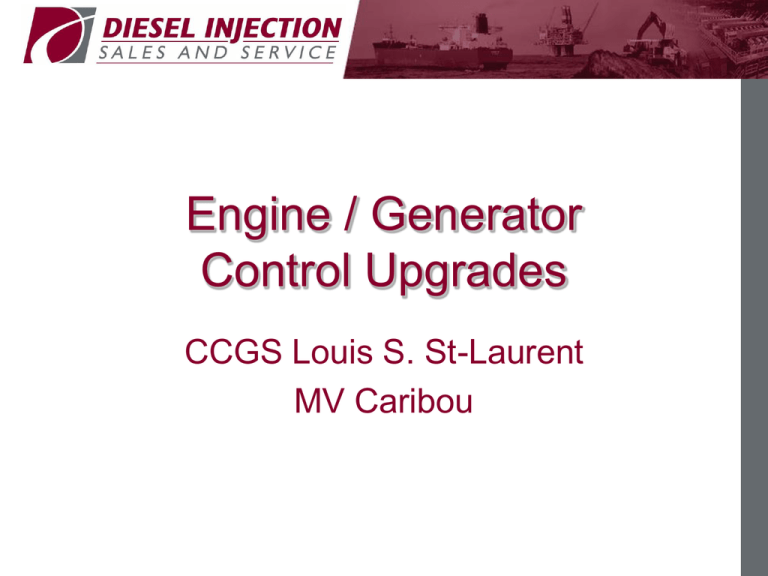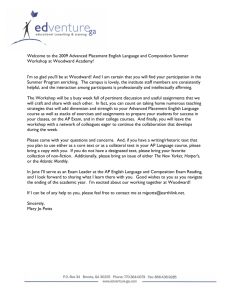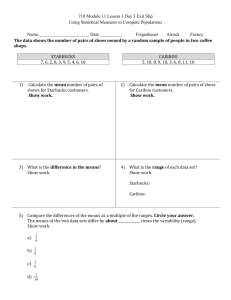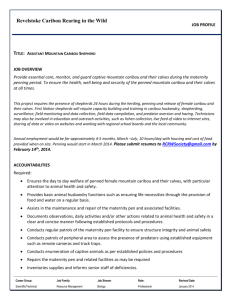Engine governing systems - Mari-Tech
advertisement

Engine / Generator Control Upgrades CCGS Louis S. St-Laurent MV Caribou CCGS Louis S. St-Laurent CCGS Louis S. St-Laurent Flagship of the CCG Fleet Built at Canadian Vickers, Montreal, PQ In service 1969 & modernized 1988 Heavy Icebreaker - Ice Class 100A CCGS Louis S. St-Laurent Diesel electric AC/DC Triple screw – fixed pitch 5 Krupp Mak 16M453C main engines 3 General Electric DC motors Total propulsive power 20,142 kw Propulsion bus 6.6Kv and 560A CCGS Louis S. St-Laurent Concerns Load control and sharing units, synchronizing units and governors suffering from many age related dynamic problems Hunting Instability - ramping Operating outside control window Difficult to set up and retain settings Units obsolete and parts availability an issue CCGS Louis S. St-Laurent Removed Speed & phase matching synchronizers provided frequency & phase matching Automatic generator loading control units to soft load machines in and out of the load sharing loop Generator load sensors Woodward 1000 Series speed controllers Prototype dual dynamics CCGS Louis S. St-Laurent Installed Woodward EGCP-3 Load Managers Replaced speed & phase matching units, load sensing units, and loading control units Reserve functionality for further modifications Woodward 828 electronic speed controllers Woodward EGCP - 3 Woodward EGCP 3 In this application it handles: Load sharing Power factor Synchronization Sequencing Before & After EGCP-3 Louis St. Laurent EGCP-3 Passenger Ship Example The EGCP 3 is capable of much more: Generator/engine protection bus protection reverse power start/stop, etc see handout Woodward 828 Woodward 828 Designed for controlling load and speed of engines in generating set service Has internal circuitry and connections designed for use in load sharing systems Two speed inputs Four analog inputs, three analog outputs Eight discrete inputs, three discrete outputs Two Speed Inputs? Systems with low frequency oscillatory modes due to engine and driven load inertias and flexible couplings are difficult to control. In some instances a coupling by itself can produce torsional frequencies. We don’t want the actuator to respond to speed sensor changes it cannot control with the fuel. The two speed inputs permit dynamic filtering. Or the two speed inputs can be used for redundancy reasons Dual Dynamics? In a marine application Main engine clutch: out vs engaged SS Gen circuit breaker: open vs closed In other applications Idle speed vs rated speed Diesel fuel vs natural gas SPEED RESET ADJUSTMENT GAIN ADJUSTMENT COMPENSATION ADJUSTMENT TIME Externally Switchable Dynamics 1st Dynamics Gain1 Reset 1 Compensation 1 Gain Ratio 1 Window Width 1 Gain Slope Bk Pnt 1 Gain Slope 1 Speed Filter Freq 1 2nd Dynamics Gain 2 Reset 2 Compensation 2 Gain Ratio 2 Window Width 2 Gain Slope Bk Pnt 2 Gain Slope 2 Speed Filter Freq 2 CCGS Louis S. St-Laurent Upon installation of 828’s and EGCP 3’s the units were tuned/calibrated to interact with Siemens. PT’s & CT’s correct, phasing, synchronization, load control, load sharing etc. Operational trials alongside & at sea Stability tests and adjustments 100% load, response times, load sharing etc Sea trials 4 days (in conjunction with Siemens trials) Arctic trials – conducted several weeks after open water trials (looking for ice for loading purposes) CCGS Louis S. St-Laurent Upgraded system responsive stable reliable TCMS witnessed test, trials and approved installation Crew given formal training on new controls CCGS Louis S. St-Laurent Issues Project done in two main phases Continuity of staff afloat and ashore Re-familiarization with project Documentation and parts Final adjustments, tuning and trials done while ship operational en-route Arctic As Fitted drawings are NEVER “as fitted” MV Caribou MV Caribou Flagship of the Marine Atlantic fleet Built at Versatile Davie Inc, Lauzon PQ In service in 1986 – (22 years ago!) Class: Lloyd’s 100A1 Ice class: Northern Baltic 1A Super 15 knot economical cruising, 22 knot max MV Caribou ASEA propulsion system Twin screw – Kamewa CPP 4 MaK 8M552 main engines – 7000 bhp ea. MV Caribou Concerns ASEA propulsion controls inputting to DEGO governor in turn controlling PGTM actuators Instability - hunting Frequent over speeds when manoeuvring Harbour entry a risky proposition DEGO unit obsolete and superseded Finger trouble MV Caribou Removed DEGO governors Removed Kamewa rack feedback transmitters MV Caribou DEGO Governors MV Caribou Installed Woodward 828 electronic governors Installed Woodward PG-EG actuators Installed PMC rack feedback transmitters MV Caribou MV Caribou MV Caribou MV Caribou Stability tests and adjustments Individual diesels response at 25, 50, 75 and 100% load response with sudden removal of 100% load crash stops and manoeuvres at 100% load Paralleled diesels at 25, 50, 75 and 100% load sudden load removal crash stops and manoeuvres at 100% load MV Caribou Upgraded system responsive stable reliable Lloyds and TCMS approved installation and witnessed tests and trials MV Caribou Issues Ship departed port immediately after undocking and trials carried out while underway and in service Blockage at turbo aftercoolers Finger trouble with original installation Woodward is programmable via hand held of lap top No individual pots providing idle temptation “As Fitted” drawings are NEVER “as fitted” Marine Type Approval Thank you!



